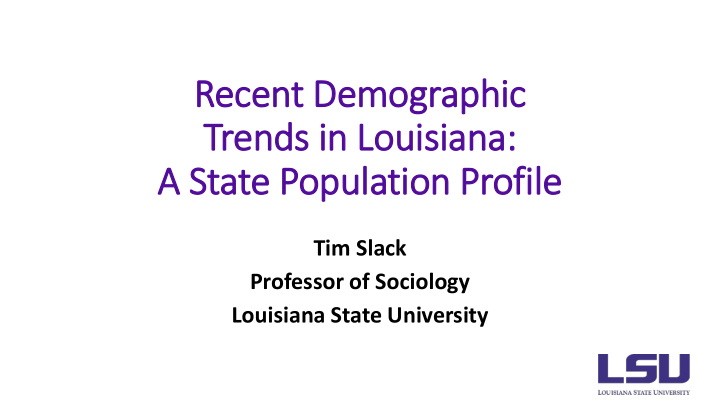



Recent Demographic Trends in in Louisiana: A State Population Profile Tim Slack Professor of Sociology Louisiana State University
Overview • Description of current state population • Trends in state population change • Components of state population change • Census 2020 and beyond
Total Population, 2018 Louisiana is smaller than the • U.S. total pop.: 327,167,434 Nation’s 10 largest metro areas New York 20.3 million • Louisiana total pop.: Los Angeles 13.4 million 4,659,978 Chicago 9.5 million Dallas 7.4 million • 25 th largest state Houston 6.9 million Washington, DC 6.2 million • (Top 5: CA, TX, FL, NY, PA) Miami 6.2 million Philadelphia 6.1 million • Represent 1.4% of U.S. pop. Atlanta 5.9 million Boston 4.8 million Source: U.S. Census Bureau, Population Division
Race, Hispanic Origin, , and Im Immigration, , 2018 Louisiana’s race, Hispanic origin, and immigrant distributions are very different than the U.S. Source: U.S. Census Bureau, Population Division
Population Change, 2010-2018 • Over decade, Louisiana’s population grew by 2.8% , a net gain of 115,446 people • U.S. grew by 6.0% • South grew by 8.9% • Ranked 33 rd among states in overall growth over decade Source: U.S. Census Bureau, Population Division
Parish-Level Population Change, , 2010-2018 Growth centers are primarily in southern part of the state Top 5 Absolute Change, 2010-18 Top 5 Total Size, 2018 Orleans Parish East Baton Rouge Parish St. Tammany Parish Jefferson Parish Lafayette Parish Orleans Parish Ascension Parish St. Tammany Parish Tangipahoa Parish Caddo Parish Source: U.S. Census Bureau, Population Division
Parish-Level Population Change, , 2010-2018 Source: U.S. Census Bureau, Population Division
Components of Population Change Demography 101: People are Born , They Move , and They Die • Natural Increase (or Decrease) • Births – Deaths • Net Migration • In-migrants – Out-migrants
Natural In Increase, 2010-2018 Natural increase is contributing to population growth • Over decade, natural increase was 159,675 • Births: 516,732 • Deaths: 357,057 • Fertility is the state’s population engine • Evidence of convergence in births and deaths over decade Source: U.S. Census Bureau, Population Division
Parish-Level Natural In Increase, , 2010-2018 2018 Source: U.S. Census Bureau, Population Division
Net Migration, , 2010-2018 Out-migration is contributing to population loss • Over decade, net migration was -34,167 • More people moving out of state than moving in • Repopulation of greater NOLA has waned, have returned to historical trend Source: U.S. Census Bureau, Population Division
Parish-Level Net Migration, 2010-2018 Source: U.S. Census Bureau, Population Division
Looking Toward Census 2020 • Every Louisianan must be counted! • Communication and outreach are critical • Challenges • Hard-to-count populations • Move to online format • Supreme Court decision on Census 2020 citizenship question? • Big potential implication for states like CA, TX, and FL • Should have little impact on count in Louisiana
Census 2020: Hard-to to-Count Communities • In 2010, 75% of state’s households mailed back questionnaire • 25% required in-person follow up • 35% of state population lives in hard-to-count neighborhoods • 26% of state households have no internet subscription Source: U.S. Census Bureau
Summary ry • Louisiana is experiencing modest population growth • But below national and regional levels • Natural increase is contributing to population growth • Fertility is the state’s population engine • Out-migration is contributing to population loss • Have returned to longer term trend • Census 2020 efforts will be critical for representation and resources
Historical Migration Trends • Out-migration is a long-term trend in Louisiana • Have witnessed negative net migration over most of last 50 years Source: U.S. Census Bureau
Source: U.S. Census Bureau
Unauthorized Im Immigrant Population, 2018
2020 Census Residence Criteria • Count people at their usual residence , which is the place where they live and sleep most of the time • People in certain types of group facilities are counted at the group facility (e.g., prisoners) • People who do not have a usual residence, or who cannot determine a usual residence, are counted where they are on Census Day (April 1, 2020) Source: U.S. Census Bureau
2020 Census Move to Online Format • Bureau plans to invite about 80% of U.S. households to submit via internet • Will follow up via mail for those who do not respond • Will mail to remaining 20% of households, targeting areas with low internet access and/or larger older-adult populations • If households still do not respond, the Bureau will send census field workers (enumerators) door-to-door to collect their data Source: U.S. Census Bureau
Recommend
More recommend